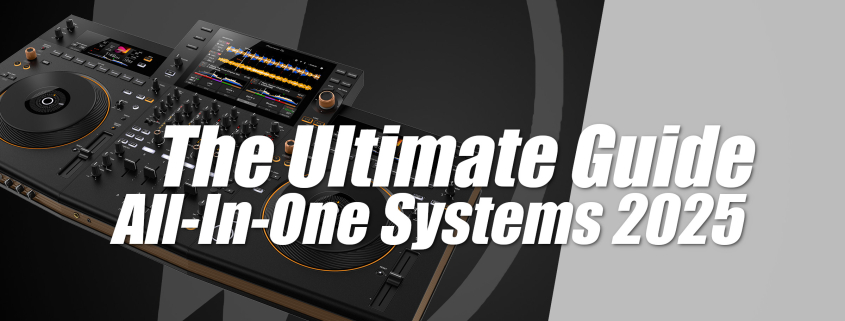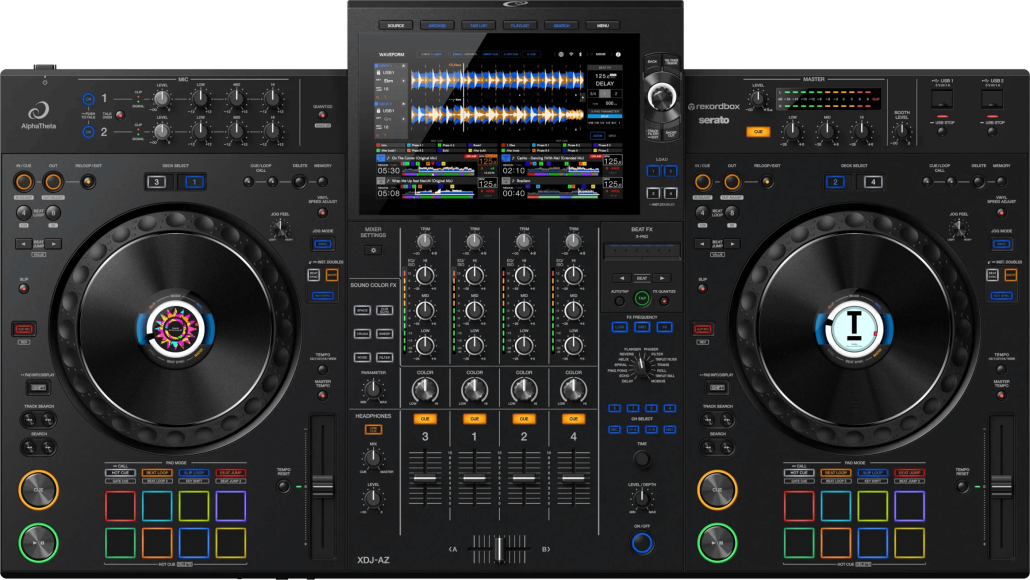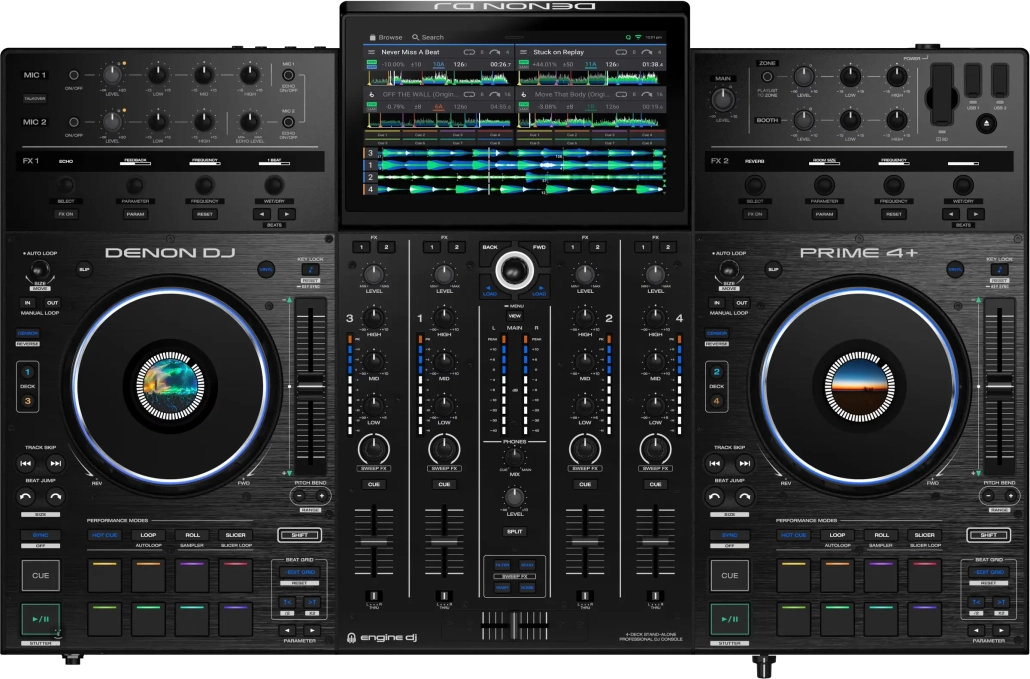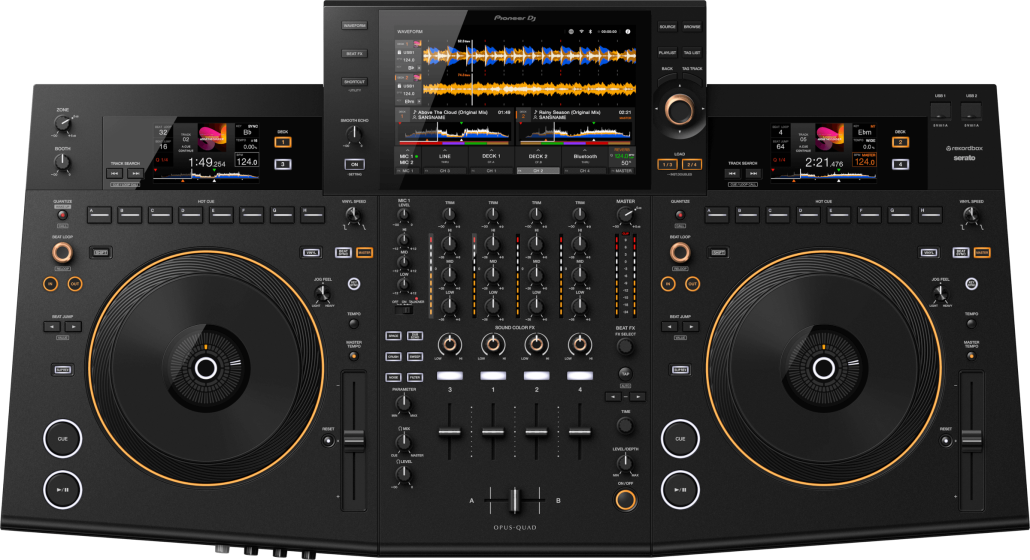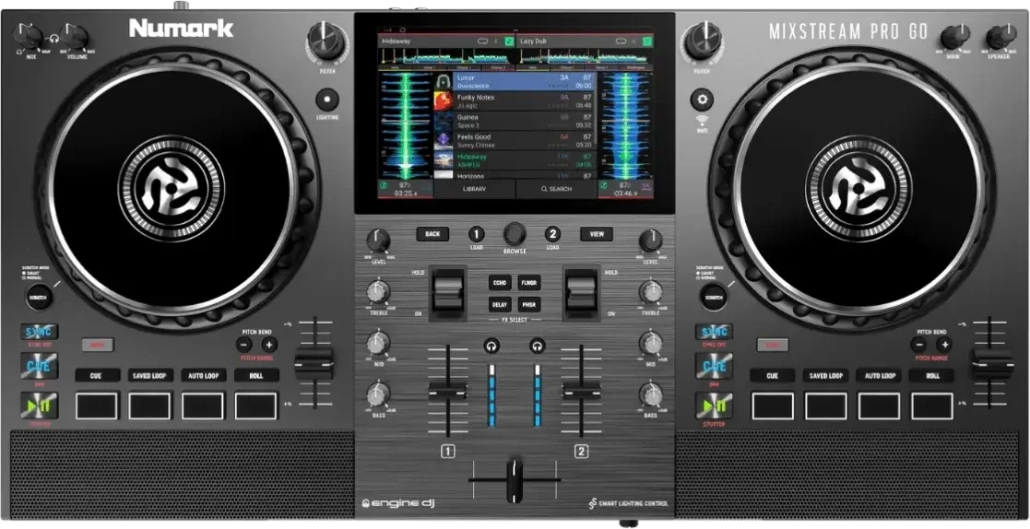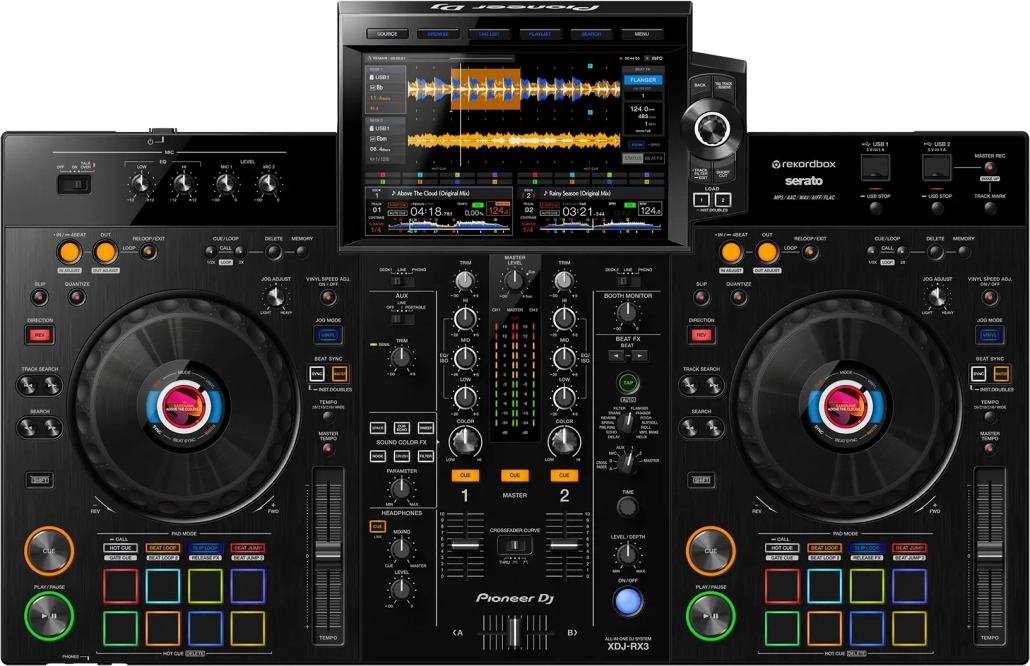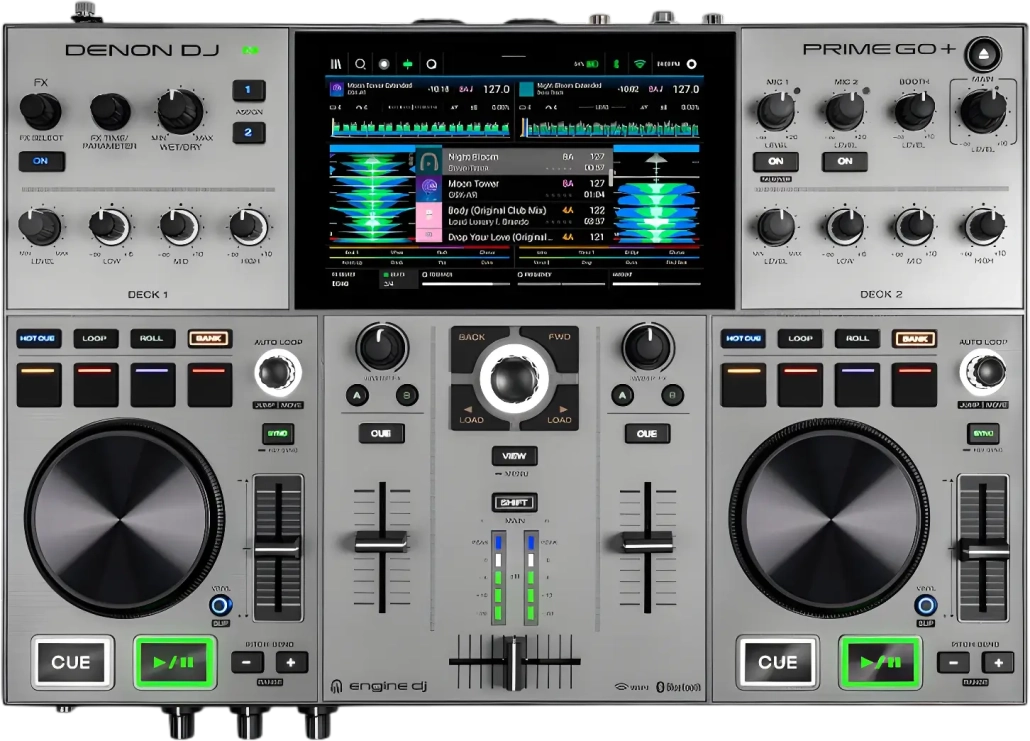The Ultimate Guide to Standalone & All-In-One DJ Systems in 2025
Over the last 10 to 15 years, the world of DJing has changed dramatically. While DJ controllers connected to a laptop remain the most popular choice for digital DJs, standalone DJ systems – also known as “all-in-one” systems – are rapidly gaining traction. They offer a powerful and streamlined alternative for DJs who want to leave the laptop out of the DJ booth.
This guide explains what standalone systems are, who they’re for, and presents the best models available in 2025.
What is a Standalone DJ System?
At first glance, a standalone DJ system looks a lot like a large DJ controller. The crucial difference, however, is that it does not require a laptop to operate. These units have a dedicated, built-in “computer” and a screen that displays all the necessary information.
Music is typically loaded via a USB drive or SD card. Modern systems even allow for streaming music from the cloud or from services like Amazon Music. Despite their independence from a laptop, they offer most of the features you’d expect from software-based DJing, such as waveforms, beatgrids, sync, hot cues, and effects.
Why Choose a Standalone DJ System?
The appeal of standalone systems lies in their simplicity and reliability.
- No Laptop Needed: The most obvious benefit is that you don’t have to bring a laptop into the DJ booth. This saves space, reduces potential points of failure, and makes for a cleaner setup.
- Ideal for Mobile DJs: Many mobile DJs appreciate the convenience and reliability of not having to set up a laptop at every gig.
- Powerful Features: The technology is highly advanced. With touchscreens, smooth graphics, and integrated music streaming services, they feel like fully-fledged computers designed specifically for DJing.
- Forward-Thinking Technology: While the most cutting-edge features like stems often appear on laptop systems first, standalone gear is never far behind. Engine DJ is considered a technology leader in this space and was the first standalone platform to offer stems support.
It is important to note, however, that a laptop is often still needed for the best experience, specifically for preparing your music library and exporting it to a USB drive.
The 5 Best Standalone DJ Systems of 2025
Based on dozens of reviews, tests and real hands-on experience, here are the top recommendations, covering a wide range of needs and budgets.
AlphaTheta XDJ-AZ
Quite simply, the AlphaTheta XDJ-AZ is the ultimate flagship four-channel standalone system and the direct replacement for the super-popular Pioneer DJ XDJ-XZ. It’s the unit many working DJs were waiting for, designed to deliver an experience that is as close as possible to a professional club setup—namely the CDJ-3000 multi players and the DJM-A9 mixer—without the high price and complexity of buying separates. It achieves this by borrowing its layout and key features directly from that club-standard gear, including full-sized jogwheels that feel identical to the CDJ-3000s and an intuitive mixer section that mirrors the DJM-A9.
A major upgrade is its true four-channel standalone capability, which fixes a key shortcoming of its predecessor and gives DJs the flexibility to perform exactly how they want. Operation is faster and smoother thanks to a more powerful processor and a next-generation 10.1-inch touchscreen that can display more tracks (13 vs 8), making library navigation significantly easier.
The XDJ-AZ is highly versatile, supporting music from USB drives and offering hardware unlock for both Rekordbox and Serato DJ Pro. It features built-in Wi-Fi for modern workflows, including Rekordbox CloudDirectPlay (via Dropbox) and direct streaming from services like Beatport and Apple Music. New creative tools include the much-requested Key Sync/Shift and a useful Link Cue feature for previewing tracks directly from the library. It also introduces SonicLink, a built-in transmitter that provides an ultra-low latency wireless connection with AlphaTheta’s HDJ-F10 headphones. The sound quality has also been significantly improved with a 32-bit D/A converter from ESS Technology. While connectivity has been simplified compared to the XZ -now featuring only a single Ethernet port and two external inputs – the XDJ-AZ corrects all the major faults of the previous model, making it the most complete all-in-one system for DJs who demand a club-standard feel.
Denon DJ Prime 4+
If maximum features and cutting-edge power are your priority over a traditional “club standard” layout, then the Denon DJ Prime 4+ is the system for you. It is undoubtedly the most technologically advanced standalone unit available, designed by working DJs, for working DJs. Its standout feature is the industry’s first standalone Stem separation, allowing DJs to isolate vocals, bass, melody, and drums from any track in real-time for creative mixing and live mashups.
Powered by the ever-evolving Engine DJ operating system, it also boasts a built-in sampler, an expanded suite of over 25 customizable Main FX, and unparalleled integrated lighting control for everything from smart home lights like Philips Hue and Nanoleaf to professional DMX setups via SoundSwitch. It offers unrivaled music access with more streaming partners than any competitor, including Amazon Music Unlimited, and cheekily, it can even read and play from Pioneer DJ’s Rekordbox-analyzed collections on a USB drive.
The ‘Plus’ version is a replacement for the popular original Prime 4, featuring a more refined and “grown-up” look, rubberised buttons, and a 10% larger jog wheel surface. While its layout is less similar to club gear and its jogwheels are considered inferior to the XDJ-AZ’s, its immense power, true four-channel standalone capability, and great “bang for your buck” make it the natural choice for DJs who want a powerful alternative to the dominant Pioneer DJ/AlphaTheta brand.
Pioneer DJ Opus-Quad
For DJs who prioritize aesthetics as much as performance, the Pioneer DJ OPUS-QUAD offers a completely new approach to standalone systems, aiming to create a harmony between outstanding, award-winning design and musical playability. With its unique angled shape, brown and brass-effect details, it’s designed to look like a stylish piece of furniture, making it a statement centerpiece for high-end mobile DJs, trendy venues, or serious home setups.
This is Pioneer DJ’s first unit with a next-generation CPU, enabling powerful features like true standalone 4-deck playback for versatile performances. Its interface is centered around a stunning 10.1-inch glass touchscreen that provides a high-resolution, responsive experience for fast track searching with a new joystick-like Smart Rotary Selector. This main screen is complemented by a display above each full-sized jogwheel, keeping crucial track information in your line of sight without cluttering the jogwheels themselves.
The sound quality is exceptional, featuring a high-end 32-bit D/A converter from ESS Technology—the same found in flagship mixers like the DJM-A9—to deliver a clear, warm, and comfortable sound for any environment. Standout features for event DJs include a Zone Output that lets you play different music in a separate room from the main mix, all from one unit. Innovative performance controls like the on-screen X/Y pad for Beat FX, the dedicated “Smooth Echo” for seamless transitions, and the new “Smart Cue” function enhance creative possibilities.
The OPUS-QUAD supports a wide range of media sources, including USB drives (with a high-speed USB 3.2 port for SSDs), Wi-Fi for rekordbox CloudDirectPlay and streaming from TIDAL and Beatport Streaming, plus a Bluetooth input for easy guest requests. It offers plug-and-play hardware unlock for both rekordbox and Serato DJ Pro and is noted for its particularly deep integration with VirtualDJ, which makes excellent use of its powerful hardware and large screen.
Numark Mixstream Pro Go
The Numark Mixstream Pro Go proves that true standalone functionality doesn’t have to be expensive, offering incredible value for money. Hailed as the world’s first 100% wireless standalone DJ controller, this portable unit features a built-in rechargeable battery and on-board speakers, making it truly ready for action anywhere, from the bedroom to the beach. No wires, computer, or even an existing music library are required to get started.
Despite its smaller two-channel form factor and more limited hardware effects controls, it offers nearly all the functionality of the more expensive Denon DJ Prime 4+. Powered by the versatile Engine DJ operating system, it provides direct Wi-Fi access to streaming services like Amazon Music Unlimited, TIDAL, and Beatport, allowing you to mix millions of tracks on the fly. The unit can also wirelessly control Philips Hue and Nanoleaf smart home lighting, or even professional DMX lighting setups via SoundSwitch software (though this requires a subscription and separate hardware).
For added flexibility, its “Computer Mode” allows it to be used as a software controller for Serato DJ and Virtual DJ. While primarily designed for hobby and home use, its combination of portability, powerful features, and affordability makes it a standout choice and a fantastic entry point into standalone DJing.
Pioneer DJ XDJ-RX3
A worthy successor to the immensely popular XDJ-RX2, the XDJ-RX3 brings significant upgrades, most notably a stunning 10.1-inch high-resolution touchscreen, the largest ever on a Pioneer DJ all-in-one system. This, combined with a faster processor, makes browsing playlists, mixing tracks, and applying effects far more intuitive and enjoyable. The unit inherits a host of features directly from the club-standard CDJ-3000 multiplayer and DJM-900NXS2 mixer, including the full suite of 14 Beat FX and 6 Sound Color FX. The jog wheels have also been improved, featuring center LCD screens that display track artwork and playback position, plus a “Feeling Adjust” control to customize their weight.
While it offers the familiar look, feel, and workflow that makes it an excellent choice for DJs practicing for club gigs, it has some notable limitations. For instance, it offers no cloud music functions and lacks the excellent “Key Sync” feature found on the flagship CDJ-3000 players. Despite these omissions, its robust build, improved usability, and added hardware unlock for Serato DJ Pro make it a powerful and reliable workhorse for semi-pro DJs and small venues.
Denon DJ Prime Go+
This model is a small but welcome update to the popular original, solidifying the Prime Go+ as a wonderful, ultra-portable unit for professional DJs who need a second system. Described as a shrunken Prime 4+ with a battery or a “professional Mixstream Pro Go minus the speakers”, it is designed as a reliable and unshowy workhorse. It’s a perfect choice for mobile DJs handling complex bookings, such as needing a setup for the outdoor segments of a wedding, and has also proven popular with portable livestreamers.
The “Plus” version brings several key enhancements, including a 25% improvement in battery life, a faster processor, and expanded streaming options with a new DRM chip that adds Amazon Music to its wide selection of services. Despite its compact size, it packs a full suite of professional inputs and outputs, including balanced XLR main outs, a booth out, and two combo jack microphone inputs. Running on the ever-evolving Engine DJ operating system, the unit offers a powerful feature set that includes a built-in sampler, extensive FX options, and integrated lighting control for Philips Hue, Nanoleaf, and DMX systems.
While some DJs dislike its idiosyncratic layout and tiny jogwheels, and the removal of the dedicated Ethernet port is a notable omission for a pro unit, the fact that the design remains largely unchanged is a testament to how good it was to begin with. It remains a little marvel of a standalone unit, packing great audio quality and robust construction into a true “grab and go” package.
Conclusion
Standalone DJ systems are no longer niche products; they are a serious alternative for DJs of all skill levels. They combine the tactile feel of traditional hardware with the power of modern digital technology. Whether you’re a professional seeking a reliable solution for gigs or a hobbyist who wants a clean setup at home, there’s a standalone system that will be perfect for you. When making your choice, trust your instinct as much as the specs. Choose the gear that inspires you and that you feel comfortable using.

